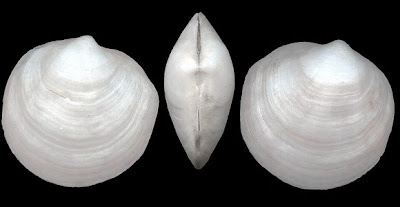Hydrogen sulphide is toxic to the seagrass and should build up as more organic matter accumulates over time. Until a new paper in Science, it was unclear how the plants coped with the gas. Seagrasses do transport oxygen to their roots, which is released into the surrounding soil, mitigating against the toxic effects of sulfide. But, sulfide production can outpace the transport of oxygen, especially at higher temperatures, which should result in reduced productivity and mortality.
Seagrass meadows are, in contrast, persistent and highly productive, which suggests that there's more than oxygen transport going on. The paper provides data to show that burrowing Lucinid bivalves commonly co-occur in high abundance with seagrass meadows. And furthermore, the Lucinids increasingly diversified as seagrasses evolved and became more common in the oceans.
 |
| The lucinid bivalve Loripes lacetus (photo idscaro seashell directory) |
 |
| The seagrass Zostera marina, which is very similar to Z. noltii (image wikipedia) |
The results largely confirmed the hypothesis that there is a three species symbiotic relationship. Seagrass benefits from the removal of sulfide by the bacteria-bivalve symbiosis and the bivalve benefits from the oxygen provided by the seagrass. Furthermore, in the wild the bivalve may benefit from the presence of seagrass because seagrasses indirectly stimulate sulfide production by accumulating organic matter in the soils beneath the growing meadows.
The results have potentially significant implications for seagrass conservation. Many conservation projects attempt to restore lost seagrass meadows by moving plants from other locations were they're doing well. But, the results of this procedure are mixed. This research suggests that moving the bivalve as well as the seagrasses might lead to greater success.
Tjisse van der Heide, Laura L. Govers, Jimmy de Fouw, Han Olff, Matthijs van der Geest, Marieke M. van Katwijk, Theunis Piersma, Johan van de Koppe, Brian R. Silliman, Alfons J. P. Smolders, & Jan A. van Gils (2012). A three-stage symbiosis forms the
foundation of seagrass ecosystems Science, 336 (6087), 1432-1434 DOI: 10.1126/science.1219973

No comments:
Post a Comment
Note: Only a member of this blog may post a comment.